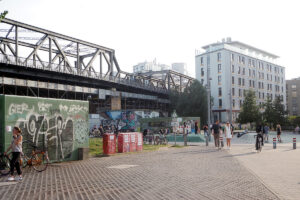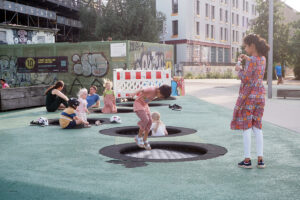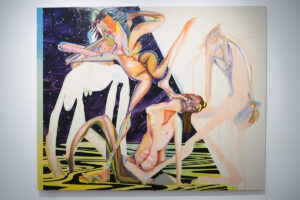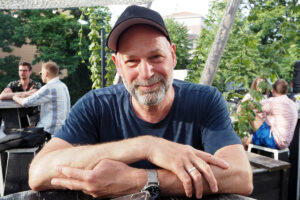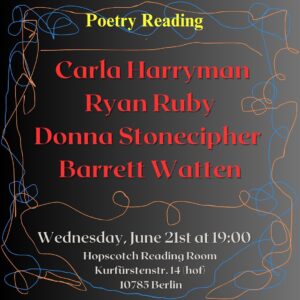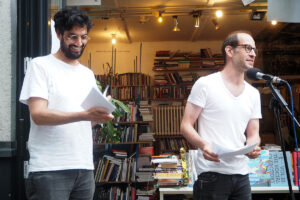Tuesday, June 20
Martin Eder, Elysium
Galerie EIGEN + ART
I.S. Kalter/Yana Tsegay
Mountains Gallery
On this day we determined to meet poet Donna Stonecipher and spend some unstructured time with her. We would begin with Galerie EIGEN + ART, last hold-out of the gallery wave that defined Auguststraße as emergent art district twenty years ago and representative of the Leipzig School, notably Neo Rauch. Most of the galleries that traversed the merger from East to West have left—most recently the conceptual gallery Barbara Wien—but EIGEN + ART kept its original location while branching out. (A search to find out what happened to the former Waschmachine gallery yields no trace but ads for the Whiteware brand of washing machine and “Hot German girl fucks dildo on Waschmachine,” on Xhamster). Such references intersect, in their vulgarity, with the work on view: a theatrical series of hyper-post-consumer-utopian-quasi-religious-fantasy tableaux by Martin Eder titled Elysium. As the gallery handout reads: “Since there are no blemishes, no disease, no suffering, and thus also no death in Elysium, the fresh moisture on the figures’ skin must come from the dew on Paradise’s meadows. ‘Dewy,’ as the beauty tutorials in the Internet call it.” The stretch from the conceptual rigor and ideology critique the gallery brought to Berlin, to the cynical avowal of kitsch grandstanding as having somewhat the same effect, defines the times we are in. Not much comment to make, so we proceed to a late lunch and walk a mile across Linienstraße to Pro QM Buchhandlung, nearby the always-beating heart of Left Berlin of Rosa-Luxemburg-Platz, the Volksbühne, Babylon Mitte, and the headquarters of Die Linke. After the surrealists’ calling as “specialists in revolt,” Pro QM sells books for “specialists in transformative urbanism,” from the psycho-geographical dérives of the situationists to current architectural studies and city guides, such as the one I brought back on Eisenhüttenstadt. It is home-in-exile on an intellectual plane that shows why we came here in the first place: to map the excitement of Berlin’s evolution as a city onto critical and creative projects. It is a source of thinking the city as one is within it.
Donna writes poetry in its felt connection with architecture and urban spaces; her serial poem Model City, one example, has a modular, repetitive structure that correlates the built world with feelings of living within it. The poet Noah Eli Gordon wrote, “Model City is built from a missing antecedent, an ‘it’ as mysterious as it is familiar: What was it like? What was what like? One’s life? The city from which one fled?” Looking for this it is an occupation I have shared on many occasions with Donna on previous trips to Berlin, where it is constantly redefined—for me in the Tag des offenen Denkmals (Day of Open Monuments) project I have pursued over many years. In The Ruins of Nostalgia, her recent work, emotional states are triangulated with the architecture of destruction, still accessible in Berlin even as it covers up its history with new buildings—leading to a third term, the calm surfaces of poetic inquiry into states and sites of feeling. “Where once there had been an empty lot there was now a building. Where once there had been an empty lot there was now a building. Where once there had been farms there were now subdivisions.” Just so, the city is a process, in its abstract generality, where things are subtracted and build up; there is no single vantage point to take it in, only different aspects the next time one looks. That is a truth of Berlin: for example, the bridge over the Schifffahrtskanal, leading to the wider basin near the former Lehrterbahnhof, has undergone serial redefinition over recent decades. First, it was a remembered site of shootings of escapees from the East who tried to run barricades with their cars, memorialized in a plaque and appearing in numerous film sequences. As historical trauma yielded to domestication, its proximity to the Hamburger Bahnhof’s outdoor café gave it a gentrified quality, suitable for postcards. Most recently the M-10 extension on Invalidenstraße, with the added tram and U-bahn stops in front of the Hauptbahnhof, have made it almost invisible due to the increase of traffic, people, suitcases. The city is an archeology of memory, each time different, without guarantees. If Berlin is the paradigm of such a city, Donna has been the writer most attuned to it, capturing it in its pure form of surface, evacuation, and constant iteration.
Wednesday, June 21
Schimmer (group show)
Galerie Marten Mertens
Christina Quarles/Zineb Sinitra
Hamburger Bahnhof
Antje Blumenstein
B-Part Galerie
The urban palimpsest continues in Donna’s project to translate Fredericke Mayröcker’s Études, setting a high standard in the explosive market of new global translations. The task of the translator, for Donna, is classically exact, demanding, recording (and recoding) the everyday psychic states of the Austrian writer in a life period that has outlived its partner and is coming to terms with its past. With the quotidian, everyday, as now. Interruptions of automatic speech, eidetic images, lyric chiaroscuros enhance the effect of writing as a foregrounded depth-effect:
the mignonettes in the Augarten (back then), the two children, Rea and Manuel : jump rope and ball &c. or we sat on wooden benches at wooden tables while the treetops sweet breezes and flowers garlands, now ever oftener from me fall ……. I mean objects from my hands, the little blonde braids of the waitress at the Café Sperl who summers in the garden leaned a bit on a tree, so bushed &c., and I thought “she must be tired” or nerves of the woodlets …….
The interest of this writing (and translation) is in its state of being-recorded, in space and time. I want to connect this work of memory and self-tracking-self as entry-into-other with the present in Berlin. It could be a work of art or space where are displayed works of art: for instance, Galerie Martin Mertens. I have at times frequented this gallery and was recently part of a commercial exchange involving a painting by the artist Matthias Kanter. Art meant to be put on a wall provides a surface for reflection, renewed on a daily basis. Once back in Berlin, I expressed my interest in visiting to see what is now on view: a group show of minimalist drawing strategies, each to be distinguished from the other. I learned of a Norwegian artist now living in Berlin called Bente Stokke, who draws objects from memory while blindfolded. The trace is absolute once committed, much like this writing, in that it is calling up objects from memory and sealing them in place with description, structured by grammars of experience and loss, that irrevocably alters them. So any report is simultaneously creation and destruction, a mystery to be explored in life. Berlin itself is a sequence of surfaces that have been drawn from memory and replaced; this is what connects a group show in a minimalist gallery with the translation of Mayröcker. There is clearly a cultural assumption in common behind it, one that we may call art and which is as important in Berlin as air, water, electricity, or garbage pickup services.
An urban palimpsest is unfolding from site to site: Hamburger Bahnhof, which recurs in this writing due to the promise it once held on first arrival in Berlin. A former disused train station converted into a space for post-60s minimalist, conceptual, and installation art, with a major collection of Joseph Beuys and his generation (mostly men). Now what is the new director doing, having opened his tenure with a performance by Ellen Allien (which greeted u on arrival)? An artist promising a new direction is Christina Quarles, who announces queer identity in a project of mixed media installation, combining figurative painting with architectural elements. In crossing between genres, she reinterprets an exhibition space formerly dominated by major artists working in large-scale painting or sculpture and for whom figures were mainly spectators. My message to the new director is to please not make it so readable; let us do the work; our enjoyment will be better (the latter uttered with a jaded German accent, lingering over enjoyment and better). A similar issue of the preinscribed meaning is risked in the film studio installations of Zineb Sinitra, Dreams Have no Titles. “Sedira (born 1963) has conceived the exhibition space as a movie set where the decors of several films provide the backdrop of a live shoot in which fiction and documentary, the personal and the collective come together.” That could be a working method, it all depends on the results. “She also presents us with a cautionary tale about the failure of an emancipatory dream that for many people remains an unfulfilled promise”—here the nonidentity between metropolitan cinema and third-world emergence can only be described as “unfulfilled.” It is the space between that conveys a promise, not any kind of identity that approximates it.
Thus in a theory of urban parks, we welcome the incommensurate. My tutelary spirit of “the space between” here is Park am Gleisdreieck, where a new project in collaborative urbanism and workspace redesign called B-Part has just opened up, with meeting areas, café, and art gallery. In the gallery is an installation by Antje Blumenstein, who it turns out is represented by the Mertens gallery and is my cover artist for Questions of Poetics. The synergy is overwhelming, realized in an overlay of transparent, colored, illuminated planes that interact with light and space of the gallery itself. Art is the transformative anticipation of that which is only partly realized, yet to come, we may conclude—as we move on the next and final phase, bringing art to Berlin without a hint of redundancy.
Carla Harryman
Ryan Ruby
Donna Stonecipher
Siddhartha Lokanandi
Florian Werner
Josepha Conrad
Vijay Khurana
Sanders Bernstein
Madeleine Watts
Alex Booth
Pavel Zakrutsky
Elisa Heine
If literature may be compared to a no-man’s-land as productive site of meaning, Park am Gleisdreieck is its urban installation, while Hopscotch Reading Room is its theatrical production in a quasi-bounded space. In everyday life, nonevents unfold continuously in Park am Gleisdreieck as sources of nonintentional refreshment. As with any park, its space of play encompasses adult activities and childhood games with no differentiation of age markers. From the gallery at B-Part, with its start-up optimism of multi-use functions, to the Brlo beer garden, where age markers are in full swing of articulation, is but a short step. Everywhere in Europe age markers are stratifying populations and relegating them to their proper spaces; much the same is taking place in America, in China, in the rest of the world. Everything depends on precisely where one is in the dedicated Life Course that has been prefigured in advance and is slowly unfolding, while cities rise and fall on this displacement. So it is we propose to meet for beers in Park am Gleisdreieck with Florian Werner, along with fellow poets on our way to Hopscotch, though Donna is delayed and Ryan misses us in the crowd. Florian is at a decisive plateau in his Life Course: an urban intellectual whose chosen task is to write books on various topics of interest and publish them. For example, he has written a book about shit, and another about the cow, and yet another about the periodic table of elements. Tomorrow, we understand, he will be celebrating the publication of his most recent work Der Stuttgart-Komplex, an autoethnography of origination and return to that German city. The entire concept of place is bound up with the prospect of an eventual return at a specific point in the Life Course. What holds these works together: each defines a nonsite, marking out a space of comprehension through a displacement of some kind, held in abeyance and thus in place. Conversation is like that too: (dis)connecting the dots from one nonsite to the next, unlinking the strata. We speak effortlessly of one thing after the next, fully comprehending one another. Then it is time to leave, to make our way to the reading.
What is literature? The question has a variable answer, but the point is to come to terms with it now. In Berlin, as paradigm of global cities, the question is being answered in the form of the lifeworld that is most productive of it. Otherwise put: Berlin is the city where one can think most clearly about what the field of literature might mean. There are others who comprehend this, notably the writers-friends already named, whose portraits I have tried to make. Such a confluence is a rare occasion, and rightfully ought to be noticed. Its opposite, one may say, is Detroit or Stuttgart—but these can be productive, too. A newcomer to this space of the nonsite literary, at least to me, is Ryan Ruby—poet, critic, and public intellectual who conveys a nanocritical grasp of current trends on the social media platform known as X; is writing criticism and being noticed for it; and is soon coming out with a long poem titled Context Collapse, which he shared with me in MS. There I found a broadly historical and footnoted discussion of precisely my topic: literature, with substantial reference to writers of my own generation in the mode of a critical challenge written in verse. To the point that our contact tonight, at the reading, had already been anticipated:
109] That the publication of the first issue of This magazine—co-edited by a recent graduate and a current attendee of Schramm and Engel’s program—which is widely held to be the founding moment of what will come to be known as language writing, is almost perfectly contemporaneous with the Nixon Shock and the drafting of the Powell memorandum, which are held by David Harvey et al to be the founding moments of what will come to be known as neoliberalism, is obviously coincidental, and any implied comparison would surely be offensive to both parties, yet it is worth noting that, beyond timing they share a commitment to a politics of pure nonreferentiality, whereby words (in the case of the former) and money (in the case of the latter) are turned into floating signifiers of value (semantic, monetary) through their respective deregulations of syntax and foreign exchange markets.
In fact, it is neither coincidental nor offensive. That the neoliberal moment—c. 1973, with both deregulation of monetary exchange and the Pinochet coup in Chile a mere fifty years ago—has a direct relation to the agonistic suspension of the signifier in the moment of Language writing is not contested—the question is how it was lived. In answer, it was lived as a form of dread, a lack of assurance of what would come next once the liberationist 60s had expired in fireworks displays of the many murders of the early 70s. Ryan Ruby is picking up on the ungrounding of that moment, the opening of a no-man’s-land in time and space that continued to put its impossible question.
The reading, I would like to think, was an opening to the no-man’s-land of literature in the space of Berlin, its chosen city. An affirmation in displacement (a delay in glass) from four complementary perspectives, each partly aware of each other but granted enough freedom to ignore that. Such is the productive tension of the reading genre, never a utopian congruence, nor should it ever be. Heterotopia once again triumphs over utopian hope, a montage of the dream deferred. Everything about the Hopscotch Reading Room is marked with difference—from the owner and patron’s path to the channeling of global voices in the cosmopolitan city to the random assortment of books in little discernible order to the time, place, and manner of the event. Our difference from each other fit right in, in no special order, on a given night. At one point there was a distraction above the crowd: a somewhat large black bird, a raven or crow, had become wedged between electrical wires or exterior plumbing. Berlin Feuerwehr was called, and after the reading, untangled the bird, which flew away. Quite a lot of equipment and expertise took part in that event. Likewise parallel to our various works and their entanglements, perhaps. Many expatriates were present, the core audience for the Hopscotch series, people who had written books one had not yet heard about.The contents of the reading are listed below; it was followed by the usual endless search for an open restaurant at that time of night. On Potsdamerstraße a Middle Eastern Imbiss was selected; you should have seen us discoursing around the table as heaping portions were served. The U-2 delivered us to Warschauerstraße though the next M-10 would leave in forty minutes, so we took a cab back to Ebertystraße, not sleeping until we had packed. The next morning Ragna came by to help get our things to the Landsbergerallee S-Bahn, which with one change arrived at a congested, massive airport.
Thursday, June 22
Icelandair 529 BER > KEF
Icelandair 873 KEF > DTW
Notes and links
Texts (June 21): Fredericke Mayröcker, Études, trans. Donna Stonecipher (London: Seagull Books, 2020), 118; (June 22), Ryan Ruby, Context Collapse, MS (permission requested).
Reading at Hopscotch Reading Room (June 21): Carla Harryman, from Sue in Berlin and Cloud Cantata; Ryan Ruby, from [t/k], with Vijay Kurana; Donna Stonecipher, from The Ruins of Nostalgia and new poem; Barrett Watten, from “The Meridian as Archive,” “Unthought,” and “Notzeit (After Hannah Höch).”
Images: all photos (c) Barrett Watten 2023; reproduce by permission only.
For travels in Iceland, Magnetic North I here.
For Norway, Watten/Viken and Utness families, Magnetic North II here.
For Oslo to Rügen Island, Magnetic North III here.
For entry into Berlin, Magnetic North IV here.
For last nights in Berlin, Magnetic North V here.
